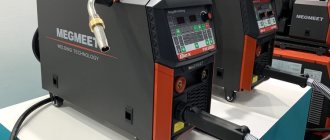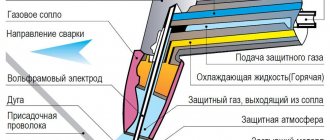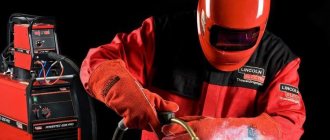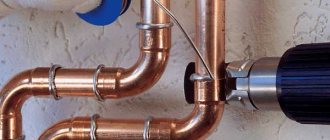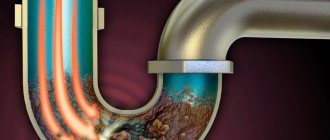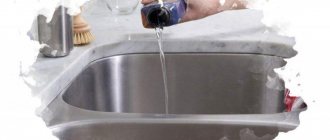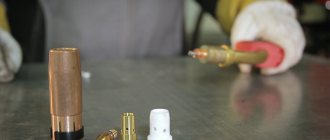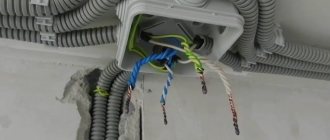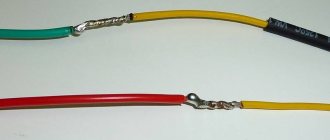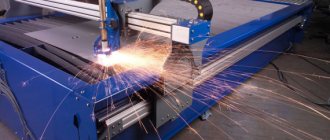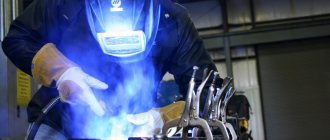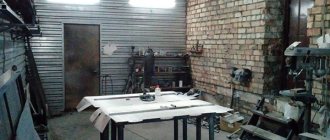Home / Accessories and parts
Back
Reading time: 2 min
0
717
The complete set of any device includes, of course, a cable for welding. But its length is often up to three meters - this is not enough.
Amateurs have no problem extending carriers to the length they need; of course, it is not at all guaranteed that they will follow all the instructions and not violate safety rules.
But real experts have a dilemma: “Is it worth increasing the length of the cable for equipment, or is it not for nothing that it is so long?” So the topic of our article is very useful and in demand, especially for those who want to learn something new and useful.
It may seem to you that choosing a good extension cord is a piece of cake, you just go to the store and say what you want, but before that you need to make some measurements, without which you will not be able to purchase an extension cord for a welding inverter, but this is not at all true.
We must take into account a huge number of factors, such as the diameter of the wire, and a lot of other characteristics, for this we wrote our article, so that you can better navigate when you find yourself faced with a large selection in the store.
- Types of extension cords
- Parameter calculator
- Purpose
- Bottom line
Cable requirements for a welder
“What extension cord is needed for a welding inverter?” is the most common question asked by beginners. Taking into account the specific operating conditions, the carrying wire for welding must have the following properties:
- ability to transmit high currents;
- flexibility to move the device around the work site;
- resistance to mechanical damage;
- quality that ensures uninterrupted and safe work.
If the above requirements are met, it is possible to use an extension cord for the welding inverter for welding work.
Application
So, you have selected and purchased extension cables. It would seem that it’s time to connect them and start welding. At this stage, many beginners make a number of mistakes, due to which the cables are not effective enough or do not work at all.
First, always straighten the inverter extension cord before use. Don't let it twist into knots or break. This applies to cables of any length. Decide in advance what maximum length is optimal for you and do not buy too long cables, which will be wound into a reel for most of the welding. This is an irrational use. In addition, when coiled, cables can cause increased induction. This is fraught with melting of the wires and failure of the inverter itself.
Also ensure that extension cables do not overheat during operation. Check the wires periodically and pick them up. If you can hold it calmly for a few seconds, then the temperature is not higher than normal. And if the cable gets so hot that you cannot handle it without gloves, then you need to stop welding and check the integrity of the cable.
Excessive heating of the cable also leads to failure of the welding machine and destruction of the cable itself.
As for storage, you need to be careful here too. Do not wrap the wires tightly, as this will deprive them of natural ventilation. Try to store cords in a dry, clean place and do not leave them outside or expose them to direct sunlight. Make sure that the connecting contacts and the cable plug do not become dirty or rusty.
Classification
The variety of welding units has given rise to a wide selection of conductors, which differ in the number of cores:
- Single core cable . Possessing good elasticity and conductivity, it is used in the operation of welding inverters for household use.
- Twin cable . Each core transmits its own charge - positive and negative. Due to its high conductivity, this cable is used in pulse welding.
- Three-core cable . Used in industrial devices operating at a voltage of 380 V.
The welding cable is made of copper or other metals with high current conductivity.
Conductors are marked with letters and numbers. Explanation of the designations of the most popular extension cords for welding inverters is given below :
- 1-3 – determines the number of cores;
- VChP / VCh P – high-frequency current of direct/alternating nature;
- HL – cold-resistant. Can be used at temperatures down to -60 Cº.
- T – tropical. Can be used at temperatures up to +55 Cº.
The most used types are:
- KG – flexible cable;
- KS – welding cable;
- KOG is a particularly flexible cable. A variation of the previous brand. Designed to operate under alternating voltage conditions of 220 V, or constant voltage of 700 V.
When choosing a cable for a welding machine, it is recommended to find out the cross-sectional diameter of the factory cable, as well as the size of the terminals.
Selection of section and length
Errors in choosing the required cable cross-section can result in short circuits , which significantly reduce the service life of welding equipment. Under conditions of small cross-section, the current condenses on the fuses. The emergency protection system will respond to this by periodically de-energizing the device.
The ratio of current and power to the cross-section of the welding cable for conductors made of copper and aluminum is indicated in the table:
Selection of the required cable cross-section based on the current and power of the welding machine.
As production tests show, increasing the length of the remote wire does not affect the operating parameters and quality of the weld. However, the vast majority of operating manuals recommend using a cable with factory parameters, and after it wears out - with similar characteristics.
ALMAZ-GORY.RU
Selecting an extension cord for the welding inverter.
Very often, customers ask the question - “Which extension cord should I choose for a welding inverter or a welding transformer?” Let’s try to answer the question of what to consider when choosing an extension cord for welding, more precisely for connecting welding machines, both inverters and transformers.
Read the welding machine instructions carefully. Determine what is the rated power and current of the welding machine. Typically, household inverters and transformers are designed for rated power from 4.0 kW to 5.5 kW at a rated current of 16 Amps (not to be confused with welding current, the value of which can vary from 20-160 Amps) .
Devices over 5.5 kW are already more suitable for the classification of semi-professional and professional welding machines.
Decide on the intensity of use of the welding machine. The intensity of work is determined by the frequency of use, the length of the continuous weld, etc. If you intend to use a welding machine for welding small parts, or for welding in the manufacture of small forms (greenhouse, gazebo, barbecue, fence, porch, etc., even for use in small construction), such use can be conditionally classified as low-intensive use. The use of the device in production, during large-scale construction, for daily constant welding is conditionally classified as high-intensity use.
These conditions are a priority when choosing an extension cord for a welding machine. They determine the choice of wire cross-section. For household welding machines (inverters) with low and medium intensity of use, extension cords with a wire cross-section of 2.5 mm and grounding are suitable. That is, when choosing an extension cord for a welding machine / inverter, pay attention to the wire cross-section.
Example:
Extension cable on reel 40 m “Leader” KG 3x2.5 mm
The number “3” indicates that the wire has 3 conductors, “phase”, “neutral” and “ground”, that is, the extension cord is grounded.
The number “2.5” indicates the cross-section of each core.
The letter index KG or PVS indicates the brand of extension cord. You can read more here:
Types of wire for an extension cord on a reel
If the power of the welding machine is over 6.0 kW or the intensity of use of the inverter transformer is high, or the welding machine is designed for 380 Volts, then you can either order an extension cord with a cross-section of over 2.5 mm by calling: 8-495-778-39-90 or by sending an order to our email. You can select a 380 Volt extension cord by clicking on the link in the sections:
Extension cords 380 Volt in coils, “Specialist” series
Extension cords 380 Volt on a metal coil, “Professional” series
General recommendations for choosing an extension cord for a welding inverter / transformer
-The metal extension cord coil is more reliable when working with a welding inverter/transformer, as it is less susceptible to thermal and mechanical damage. All about extension cord coils here: TYPES OF EXTENSION cord COILS
-The presence of 2 or more sockets on the extension cord is preferable, based on the fact that when welding work, the connection of an additional tool is required - an angle grinder (grinder) or other stripping and cutting tools for cutting metal or cleaning seams. We especially draw your attention to the fact that when ordering a 380 Volt extension cord, it is advisable to have one/two 220 Volt sockets on the extension cord.
-The KG extension cord wire is less susceptible to mechanical and thermal damage than the PVS wire, and can also be used at subzero temperatures. All about the extension cord wire is here: Types of extension cord wire
— It is more convenient to use and store the extension cord on a reel, since when winding and unwinding from the reel, the extension cord does not bend, break or twist into knots, which is an additional guarantee against breakdown of the wire.
— It is not worth purchasing an extension cord with a large supply of wire in cross-section and length, as this makes the product itself heavier, and besides, a wire with a larger cross-section is more expensive.
— The presence of a circuit breaker in the extension cord for the transformer inverter is not advisable, since welding machines usually have their own protection against overheating and overcurrent, and an additional circuit breaker will only interfere. (Choose an extension cord without the AZ-circuit breaker index in the name of the extension cord)
Extensions for welding of the Umelets series
Extension cord on a reel 50 meters (3*2.5 PVS) “Craftsman” article: 13198 price: 3126 rub.
Extensions for welding “Master” series
Extension cord on a reel 50 m (3*2.5 PVS) “MASTER” article number: 10198 price: 3270 RUR Extension cord on a reel 50 m (3*2.5 KG) “MASTER ” article number: 11207 price: 4490 RUR
Extensions for welding inverter series “Brigadier”
Extension cord 50 m (3*2.5 PVS) metal coil “BRIGADIER” article: 14227 price: 3,770.00 rub.
Extension cord 50 m (3*2.5 KG) metal coil “BRIGADIER” article: 17230 price: 4,871.00 rub.
Extensions for welding inverter series “Leader”
Extension cord on a metal reel 50 m (3*2.5 PVS) “LEADER” article: 10227 price: RUB 3,902.00
Extension cord on a metal reel 50 m (3*2.5 KG) “LEADER” article: 14213 price: RUB 5,144.00
Extensions for welding machines of the Paritet series
Extension cord “PARITET” 50m 1 rose PVA 3*2.5 coil / vr rubber article: 10100 price: RUB 3,107.00
Extension cord “PARITET” 50m 3 roses PVA 3*2.5 coil/cr rubber article: 10115 price: 3,367.00 rub.
Extension cable 50 m 3*2.5 mm KG 1 socket “PARITY” / vr rubber article: 10130 price: 3,942.00 rub.
Extension cable 50 m 3*2.5 mm KG 3 sockets “PARITY” /kr rubber article: 10145 price: 4,165.00 rub.
Calculation example for selecting an extension cord
The maximum permissible length of a copper welding cable is determined by the ratio of the maximum cross-section to the correction factor . It is determined by the base current strength:
- 200-500 A. The correction factor is “2”;
- up to 200 A. The coefficient is equal to the result of dividing the applied current by 100.
For example, let’s calculate the maximum allowable length for the Brigadier MMA-180S inverter. The current strength is 180 A. Since the current strength does not exceed 200 A, the correction factor will be 180/100 = 1.8. The manufacturer recommends using a power cable with a cross-section of at least 16 square meters. mm.
Thus, when working with this inverter, the maximum permissible length of the welding cable is: 16/1.8 = 8.89 (meters)
How to properly extend welding cables
- Log in to reply to this topic
#41 Valera1963
- Top
- Insert nickname
#42 Rust_eze
- Participant
- Messages: 736
- City: Irkutsk region. Usolye-Sibirskoye
Dr_MMA, Yes, 12 turns of 16 mm 2 cable on regular transformer hardware. The cross-section of the magnetic circuit is about 60 mm 2.
But it will be necessary to redo it, make several taps for different numbers of turns. Since the power of the device with such a throttle doubled. But at the lowest current it is no longer possible to cook a car tin with it - it burns through. You have to disconnect it. And everything with a thickness above 2mm cooks calmly.
- 1
- Top
- Insert nickname
#43 copich
- Moscow city
Dr_MMA , Yes, 12 turns of 16 mm 2 cable on regular transformer hardware. The cross-section of the magnetic circuit is about 60 mm 2.
But it will be necessary to redo it, make several taps for different numbers of turns. Since the power of the device with such a throttle doubled. But at the lowest current it is no longer possible to cook a car tin with it - it burns through. You have to disconnect it. And everything with a thickness above 2mm cooks calmly.
Features of choice
The choice of cable for the welding unit is carried out depending on the following parameters:
- Voltage in the working network . The parameter specified in the passport must not be less than the network value.
- Device power . As the power of the device increases, the current increases.
- Operating temperature . The operating temperature range of a standard cable is from -20 to +40. If the operating temperature exceeds these indicators, use a cable of a certain design - cold-resistant or tropical.
- Planned bend radius . The minimum bending radius of KG class cables is the sum of eight outer radii. If this condition is not met, it recommends using cables of the “KOG” class - especially flexible cables.
When choosing a cable, pay special attention to the manufacturer's information. By some signs you can determine the quality of the product:
- Cross-sectional area . The product of a responsible manufacturer indicates the usable area of the core.
- Vein formation . A large number of wires indicates flexibility and good throughput.
- External insulation . PVC shell instead of rubber increases service life.
- Wire material . High-quality products are made from copper.
